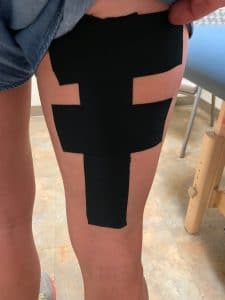UPDATED May 28, 2022: I’ve been a runner for most of my life. And I have made most of the common running mistakes runners make along the way.

When I was young, I could get away with a lot of running mistakes. As I get older, I have realized the importance of being intentional with my training. As I have become more competitive, I have learned many of the common running mistakes I have been making for much of my running career.
While being a “runner” has always been part of my identity, I never knew much about proper training. For instance, (before kids) my husband and I would regularly meet after work to run 16 miles, followed by stadium steps, and then go home to eat…wait for it…cereal. We didn’t fuel or take time to recover. We’d hit the roads hard the next day.
I want to help you run and feel your best. After all, that is my main mission with this site. So, for this article, I am highlighting ten common runner mistakes to help you avoid the running mistakes I have made.
I chose these common running mistakes because they’re detrimental to any runner: they hurt your performance and ruin the fun. While many of these actions come from a good place—you want to be your best running self—they are also rooted in fear which clouds your best judgment.

If you make these common running mistakes, you won’t succeed as a happy, healthy, or fast runner. So, if you do, check yourself. It’ll make your running better and much more satisfying.
Top Ten Common Running Mistakes Runners Make
Running Mistake #1: Comparing yourself to other runners.
Comparison is the thief of joy. Let me say that again. Comparison is the thief of joy. Prior to training with a coach, no one knew how fast or far I was running but me. I didn’t have a Garmin watch. I didn’t use Strava.
Related: Garmin Stats Explained
While knowing what you run can be crucial for your training, putting it out there for the world to see can be dangerous. It tempts you to run faster or farther than you should to essentially show off to the running world: Cue Ron Burgandy from Anchorman, “EVERYONE. LOOK HOW AWESOME I AM!” Even more dangerous is looking at other people’s runs and comparing your performance to theirs.
There have been so many times that a run I was proud of was dampened by looking at other people’s similar runs. When I was training for an Olympic Trials Qualifier (OTQ), I’d compare workouts of other runners’ with OTQ goals and all faith in my training would be lost. This does nothing but fuel negative thoughts. “I will never be as fast as her.” “I will never get my goal.”
Related: 9 Mental Training Tips for Runners
Running is an individual sport with SO MANY VARIABLES. It shouldn’t matter what other people are doing. What matters is that you are showing up, running smart, and doing your best…every day. Easier said than done, I know. But if you stop being a slave to Strava, you’ll be a better and HAPPIER runner for it. Guaranteed.
Check yourself: When you start perusing Strava, think about your intention. Is it to encourage fellow runners or see how you measure up? If it is the latter, stop scrolling.
Running Mistake #2: Not Fueling Enough.
Until my late 30’s I NEVER thought about fueling for running. In fact, I viewed running as a way to eradicate what I ate. So why would I eat to run? I run to eat! HUGE MISTAKE. Especially if you want to perform well and not be a miserable mother…and runner.
When I started training more seriously, I didn’t understand how I could be expected to run intervals one day, run a long run the next, and then turn around to do more intervals. Who could possibly be recovered enough to do that?
Turns out, pretty much everyone can—if you eat right. When my coach started asking me what I was eating before and after my runs, I was shocked that I should be eating anything at all. My kids were young, so getting out to run needed to take as little time as possible—no time to eat and run!
Related: Marathon Fueling 101: What Runners Should Eat

When I started viewing food as fuel, my running transformed. I recovered faster. I ran faster. And, I had more energy to be an awesome mom to boot.
Here’s what you should be eating:
- 30-60 minutes prior to a run, eat a carb dominant snack.
- 30-60 minutes after a run, eat a carb-dominant snack with some light protein.
- For longer workouts, be sure to eat a MEAL rich in protein, carbs, and healthy fats two hours after.
- During a longer run (more than an hour), do a gel, Gu or chew every 45 minutes.
Check yourself: Ask yourself if you’re eating to run or running to eat. If you’re running hungry, or even allowing yourself to get hungry throughout the day, you need to eat more.
Related: 3 proven ways to refuel + yummy recipes
Running Mistake #3: Not listening to your body.
You know that saying, “listen to your body’s whispers before they become screams”? There’s nothing truer than that for a runner.
From 2019 to 2020, I’ve battled a hamstring injury. This would not be the case if I listened to my body early on. The injury started after I tripped on a broken road. I ignored it and continued to run the highest mileage weeks of my life. I believed that every mile would get me closer to achieving my OTQ time. Therefore, I was terrified of taking any time off.
Related: Lessons learned from my running injury

Runners need to push through pain, but we also need to know what pain is worth pushing through: If you have a nagging injury that has hurt for several days and gets worse as you run, you need to stop running and possibly see a physical therapist.
This also goes for illness. Many times, I felt like I was getting sick but opted to ignore my symptoms in favor of a run. I’d come home, tipped over the edge, and much sicker than if I’d played it safe and rested instead.
Related: Why You Need a Planned Running Break
Not listening to your body most likely will result in taking more time off in the long run. When in doubt, hedge your bets: taking a couple of days at the first sign of trouble could save you taking a couple of months off—or more.
Check yourself: Ask yourself if taking a day off will help your long-term goal. If an extra day or two of rest can stave off an injury or illness, then the answer is, yes it will. Don’t be short-sighted.
Running Mistake #4: Running too fast.
Remember when I said that being on Strava makes you want to “show off” and prove to everyone how awesome you are? That means you likely push the pace on runs where you should be running easy. Even before Strava I would make this mistake because I was competitive with myself. Every run had to be faster and farther than the one before.
Related: Benefits of an Easy Running Pace
Running too hard on easy runs is detrimental for a couple of reasons. First, it robs your body of recovery. Running hard stresses your muscles, ligaments, tendons, joints, and bones. It creates little tears that heal back stronger. They can’t do this if they’re worked hard day after day. Instead, they’ll continue to break down eventually resulting in injury.

Another reason running easy is important is that a slower pace allows biological magic to happen. Easy runs at a conversational pace allow your body to grow its capillaries and mitochondria, the vehicles for supplying fuel (oxygen) to your working muscles. Run faster than easy and you can’t run the volume that spurs these biological adaptations.
A good rule of thumb is to go really hard on your hard days and run really easy on your easy days. You earned that easy and you’ll end up being a faster, stronger runner for it.
Check yourself: If you tend to run too fast on easy days, ask why. Is it because you are showing off or you’re afraid of losing fitness? Remind yourself that easy running builds your engine.
Related: 9 running hacks that are worth your time
Running Mistake #5: Not believing in yourself.
When I was in high school, I was sitting at the dinner table with my family discussing an upcoming track meet. I was saying how I was doubtful I would get the time I wanted (I think I was trying to break 60 seconds in the 400 meters). Instead of encouraging me, my dad looked me in the eyes and said: “You’re right, Whitney. You’re a loser.”
Before you get the wrong idea—my dad has always encouraged me and told me he was proud of me every day. However, that never worked to make me believe in myself. So, he tried another tactic, reverse psychology. I remember my coaches trying all sorts of tactics too—a heartfelt card, a stern pep talk, a lie about hearing the other team trash talking me.
Related: How to overcome imposter syndrome
Not believing in oneself can cause self-destruction. If you don’t believe you can reach your goals, then every workout, every family sacrifice, every early morning run was a WASTE OF TIME.

Throughout the 7 months that I trained for an OTQ, I never believed I could accomplish it despite the people who knew me and my running best telling me it was possible. I doubted every workout. And believed that other people doubted me, too.
It became a self-fulfilling prophecy: The trip that hurt my hamstring happened WHILE talking to my friend about how I didn’t think I could run a sub-2:45 marathon. That trip and a bad attitude led me to run 11 minutes off an OTQ time–AND deal with the injury still a year later.
The power to believe in yourself is the most important quality a runner can have. Because when the going gets tough in a race, a workout, or just the grind—that is what will keep you going. So, do whatever it takes–start a positivity journal, visualize your goal, review your training logs, or get a life coach—to bolster that belief so you can accomplish all you’re capable of doing.
Check yourself: Ask yourself if you truly believe you can achieve your goal. If you don’t think you can, look for evidentiary support. I bet you won’t find any.
Running Mistake #6: Poor form.
Check yourself: Periodically while running, do a body scan to ensure your body is standing up straight and relaxed.
Running Mistake #7: Doing too much too soon.

Running is addicting. And it can be tempting to run more and more. However, studies show that if you increase your mileage too much too soon, you greatly increase your injury risk.
Running more helps you become fitter and stronger. But there can be too much of a good thing. Aim to not increase your weekly mileage by no more than 10 percent a week. This is the gold standard for all runners, new or old.
Also, take a “down week” or “cutback week” every three or four weeks in which you reduce your mileage by about 20-30 percent to absorb your training.
Running Mistake #8: No rest days.
Running Mistake #9: Being inconsistent.
One of the most common mistakes runners make is being inconsistent with their running. Runners who are inconsistent do not progress in their fitness level. They are also more predisposed to running injuries.
Related: How to Start Running: A Complete Guide
Inconsistent runners don’t get out of the state where they have aches and pains from adaption. And, they don’t reach the flow state where running feels easy and fun.
If you are new to running or getting back into running, look hard at your schedule and make appointments with yourself for when you will run. Then come up with a backup plan.
For instance, if you have young kids, you may run in the morning. But maybe your baby wakes up and wants to nurse as you are heading out the door. Can you run at lunch? Is it possible to get a sitter for later? Can you do a stroller run? It’s crucial to be flexible yet committed as a mother runner.
Running Mistake #1o: Not warming up & cooling down.
It is crucial muscles are warm before they do hard work. Runners at all levels can ensure their bodies are ready to exert themselves by slowly jogging 1-2 miles before pace and effort are intensified.
Likewise, the body needs time to cool down and recover. A light jog or 1-2 miles after a hard effort, helps keep the blood flowing, moving toxins out of the muscles so that they can recover and build back again.
Check yourself: Bank an extra 5-10 minutes before and after your runs to recover. Make it a priority.
If you want running guidance while pregnant, check out my run coaching services. Also, be sure to check out my free training plans:
